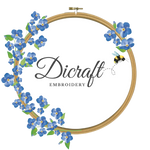Embroidery Frames and Hoops
.
A suitable frame or hoop greatly enhances your enjoyment of the finished piece.
.
About Rectangular Frames
.
.
Working on a rectangular wooden frame for larger designs is a good idea if the corners and sides would be covered by the customary round hoop. The rectangular frame should be larger than the design – this will allow enough space, so the edge of the wooden frame won’t be in the way whilst you stitch.
.
There are many kinds of frames: needlework frames, stretcher bars or bar frames, ratchet frames, scroll frames and lap frames. These are available from needlecraft stores and websites. The Q-snap Needlework frames are also great!
.
Popular products are the Evertite Stretcher Bar frames – also known as Evertite Stitchery Frames or Evertites – which have an adjustable tension, come in a number of sizes, and are obtainable from needlecraft outlets in the USA. I am sure that the frames are available in other countries too, and if you search for Evertite Stretcher Frames on Google, you may find a store or website that will post one on to you. Have a look at the article written by Mary Corbett on her website: www.needlenthread.com Search for: Evertite Stretcher Bar frames.
.
Wooden Frames
You could ask your local framer to make a frame for you, like I do. Ask
the framer to make a lightweight wooden frame. The wood should be soft
enough for you to push drawing pins (brass thumbtacks) into.
.
Hint: Another way to find a suitable frame is to purchase a ready-blocked artist’s canvas which is a suitable size. These are usually available from art and craft stores. Simply remove the canvas and if necessary, sandpaper the frame until it is smooth, before stretching your embroidery panel onto it.
.
.
Stretching your Fabric onto the Frame
Before stretching the panel onto a frame, you could add a second layer of thin cotton voile or muslin fabric on the back of your embroidery. You will then stitch through both layers of fabric. The backing fabric acts as a stabiliser, and it is easier to end off at the back. Place backing fabric on a flat surface; lay your embroidery panel on top, right side up. Tack the two layers along the edge, working through both layers to join them.
.
Using Brass Thumbtacks or Drawing Pins
Use brass thumbtacks or drawing pins to secure the panel onto your frame. Place the frame on the right side of your embroidery panel and position frame along the sides. Use a pencil and draw the outline of the frame onto the white border of the fabric. The lines will help in the next step.
.
.
Place both layers of fabric on frame, positioning it so that pencil marks line up with the frame. Insert first tack in the centre of one edge; work to the corner and then to the other corner until first side is tacked down.
.
Repeat on the opposite side of the frame, checking that the pencil line is straight. As you stretch, the lines will move further down the side of the frame. Pull gently on both layers of fabric as you tack to stretch the layers. Don’t distort the fabric; a gentle, even tension is required.
.
Tack the third and fourth sides as you did above until layers are straightened firmly in the frame, but not so much that the fabric is warped. Cover the tacks with masking tape so that your threads won’t catch on them as you work.
You could also ask someone who uses a staple gun or powered stapler to staple the fabric to the side of the frame.
.
.
Once it is prepared, the frame can be attached to a stand, which is available from some needlecraft or quilting stores. Alternatively, lean part of the frame against the edge of your worktable or sofa, to prop it up whilst you embroider.
Round Hoops
Round 15cm (6”) or 20 cm (8") embroidery hoops can be used for smaller shapes which are made separately and then applied to your design, for example the birds and butterflies or stumpwork leaves. The smaller (round) hoops are also useful when making a single roses or panels that I teach in my Roses book.
.

You can download the PDF of the tutorial for your collection here.
Hope you enjoyed this little lesson!
Until next time
Mooi bly
Groete
Di
♥









Leave a comment